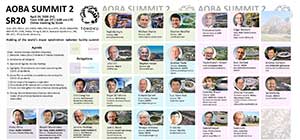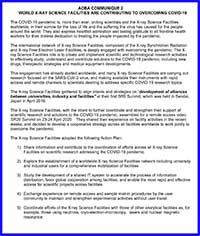Tohoku University, International Center for Synchrotron Radiation Innovation Smart
Phone +81-22-217-5204
Katahira 2-1-1, Aoba-ku, Sendai 980-8577
Revised on May 6th, 2020
 Participating organizations:
Participating organizations:
SLAC, APS, NSLS-II, ALS, CHESS, ESRF, DESY, Euro-XFEL, SOLEIL, DIAMOND, MAX-IV, PSI, ALBA, Elettra, SPring-8, SACLA, Australian Synchrotron, PAL, PAL-XFEL, TPS
& Tohoku University
[Main venue: Tohoku University, Institute for Multidisciplinary Research for Advanced Materials, 2nd floor large conference room]
https://youtu.be/paOdcPsfquw
SR20 Summit, Aoba Summit II.
 Participating organizations:
Participating organizations:SLAC, APS, NSLS-II, ALS, CHESS, ESRF, DESY, Euro-XFEL, SOLEIL, DIAMOND, MAX-IV, PSI, ALBA, Elettra, SPring-8, SACLA, Australian Synchrotron, PAL, PAL-XFEL, TPS
& Tohoku University
- Zoom recording of the meeting
- SR technology contributing to research related to SARS-CoV-2 infectious diseases
AOBA COMMUNIQUE 2 (April 24, 2020)
WORLD X-RAY SCIENCE FACILITIES ARE CONTRIBUTING TO OVERCOMING COVID-19Zoom Recording of Online Meeting on April 24
The meeting was held on 3:00p.m. JST, 6:00a.m. UTC, April 24, 2020[Main venue: Tohoku University, Institute for Multidisciplinary Research for Advanced Materials, 2nd floor large conference room]
https://youtu.be/paOdcPsfquw
Regarding next-generation synchrotron radiation use to promote suppression research of COVID-19
Tohoku University has summarized the technologies related to synchrotron radiation and then can promote researchers for various studies aimed at controlling infectious diseases (COVID-19) by the new coronavirus (SARS-CoV-2) as shown in the following list. These are based on consideration of development as a feasibility study (FS) with industry as part of the promotion of next-generation synchrotron radiation facility development. In either case, the use of synchrotron radiation makes it possible for research to perform extremely smooth and accurate measurements and evaluations.
Based on this list, it is possible to exchange information on major synchrotron radiation
facilities around the world and COVID-19 suppression related research,
and aim for more accurate and speedy research execution through mutual
exchange. Therefore, we decided to urgently hold the 2nd World Summit of
Synchrotron Radiation Facilities. At the plenary session, after exchanging
opinions on the individual research contents and utilization status of
synchrotron radiation facilities, we finally declared that the synchrotron
radiation facilities of the world will unite and confront this humanity's
greatest crisis.
Summit Agenda
For inquiries, please contact us via E-mail.
Summit Agenda
April 24, 2020 (Fri) 15: 00-Online meeting by Zoom
[Main venue: Tohoku University, Institute for Multidisciplinary Research for Advanced
Materials, 2nd floor large conference room]
AOBA SUMMIT 2 SR20, dated April 24, 2020.SLAC, APS, NSLS-II, ALS, CHESS, ESRF, DESY, Euro-XFEL, SOLEIL, DIAMOND, MAX-IV, PSI, ALBA, Elettra, SPring-8, SACLA, Australian Synchrotron, PAL, PAL-FEL, TPS
Agenda |
For inquiries, please contact us via E-mail.
- next3gev(at)grp.tohoku.ac.jp Replace (at) with @
SR technology contributing to research related to SARS-CoV-2 infectious diseases
Synchrotron radiation technology for research related to SARS-CoV-2 (new coronavirus) infectious disease (COVID-19)
Research project list (April 21, revised on April 23, Click here for pdf format) |
 |
 |
 |
 |
 |
 |
 |
 |
Call for related research projects
Based on this list, we would like to respond to requests from researchers
in companies and academic fields for using synchrotron radiation facilities
to solve various COVID-19 issues within the framework of Coalition. Therefore,
we are urgently recruiting research subjects related to these lists. Unlike
the conventional method of using synchrotron radiation facilities, the
framework of Coalition is specialized in cutting-edge practical research,
and since the selection of issues is the fastest, it usually takes six
months to one year instead of the shortest. Will be shortened to a few
days. For those who are involved in each research institution, please contact
us by e-mail for the details of application.
- sris(at)grp.tohoku.ac.jp Replace (at) with @
Feasibility Study (FS)
The Feasibility Study (FS) is an existing overseas synchrotron radiation system to embody the "coalition concept" proposed by industry and academia as a mechanism for operating synchrotron radiation facilities from advanced utilization to infrastructure utilization. The facility is being used in a wide range of fields, including biotechnology, nanotechnology, and food tech. This coalition concept was first proposed in Japan by the Photon Science Innovation Center in order to realize the next-generation synchrotron radiation facility that is being constructed on our campus. To date, more than 75 companies have announced their participation in the Coalition Concept, and more than 36 of them have participated in FS and are considering the utilization of next-generation synchrotron radiation facilities.World Summit of Synchrotron Radiation Facility
The predecessor "Next Generation Synchrotron Radiation Summit" was held in Sendai City on April 21, last year, hosted by Tohoku University, where the world's synchrotron radiation facilities met together for the first time. At the conference, "We will establish a global summit conference that will be held as a regular forum to promote collaboration between universities, industry and facilities in order to promote the use of basic and applied research using synchrotron radiation. As a result of the adoption of the Aoba Communique, the agreement was reached for synchrotron radiation facilities around the world to hold this plenary session hosted by Tohoku University.Q&A
- (1) Please tell us the purpose of holding the summit at this timing.
- Since countermeasures against infectious diseases became an urgent issue, synchrotron radiation facilities around the world have begun to focus on research related to solving the COVID-19 issue one after another. There are more than 10 such facilities worldwide in Europe, Asia and the United States. For example, it is used for structural analysis of proteins necessary for drug discovery and antibody development, and for material development of medical devices. In Japan, SPring-8 has started similar efforts. However, each synchrotron radiation facility is currently working on its own. In the Next Generation Synchrotron Radiation Program, Tohoku University, which is a member of the regional partner, is in charge of academic support for Coalition. As part of the promotion of the Next Generation Synchrotron Radiation Program, we would like to contribute to the activities of SPring-8 and other synchrotron radiation facilities by supporting the synchrotron radiation research related to COVID-19, which is a Correlation member. . Fortunately, we have signed partnership agreements with 10 overseas synchrotron radiation facilities since last year's SUMMIT conference, and we are ready to collaborate with overseas facilities. This time, we proposed to hold the second summit meeting as a place to call on these facilities and discuss cooperation between the facilities, and we received approval from nearly 20 facilities around the world. We would like to make it possible for facilities to resolve this global urgent issue quickly by providing efficient international cooperation through the division of roles. I hope that Tohoku University's activities in the development plan of the next-generation synchrotron radiation facility can contribute to that.
- (2) I heard that it was sponsored by Tohoku University. Please tell us who the researchers who will manage the meeting will be.
- Atsushi MURAMATSU, Director, International Center for Synchrotron Radiation Innovation Smart, Tohoku University
- (3) Who are the potential attendees in the US and France, and what will they be like?
-
Plans are for the United States, France, Sweden, Germany, United Kingdom, Taiwan, Australia, South Korea, Switzerland, Italy and Spain.
- (4) Please tell us how you are going to utilize the results of this conference for corona countermeasures, including future development of the conference.
- At the conference, many synchrotron radiation facilities will be discussed on how to coordinate international R & D competition in order to confront the global crisis and coordinate their results effectively. Some have argued that similar research could reduce wasteful competition and shorten R & D time. Therefore, it may be possible to standardize a remote experiment in which facilities around the world can be used in Japan by utilizing an international information network, and conversely, facilities outside Japan can use Japanese facilities. Let's We hope that by utilizing the strengths of each facility and compensating for their weaknesses, we will concentrate the strengths of facilities around the world and speed up R & D to resolve coronavirus infectious diseases. Tohoku University, which is a university, will serve as a host for facilitating discussions at the summit, and we hope that this kind of facility cooperation will lead to even more concrete implementation.
- (5) There was also a presentation to the effect that “Recruit related research projects”. Although there was a notation such as accepting applications, please let me confirm whether it is a story related to the emergency meeting or whether this "recruitment" is a story that Tohoku University will take the initiative.
- The recruitment will be conducted as part of matching the coalitions of the regional partners of the Next Generation Synchrotron Radiation Program. The center of Tohoku University will take the initiative. In addition, if the Summit will be able to be implemented at overseas facilities such as Soleil in France where Tohoku University connects the borders, SLAC in the United States, and MAX-IV in Sweden, the next-generation synchrotron radiation plan will be urgent. I think that it has helped a little to take a step forward in the international collaboration of the facilities of the time.
-----
International Center for
Synchrotron Radiation Innovation Smart
Synchrotron Radiation Innovation Smart
Katahira 2-1-1, Aoba-ku
Sendai 980-8577
Tohoku Univ.
TEL +81-22-217-5204
FAX +81-22-217-5211
Partner Organization:
![]() Photon Science Innovation Center
Photon Science Innovation Center
